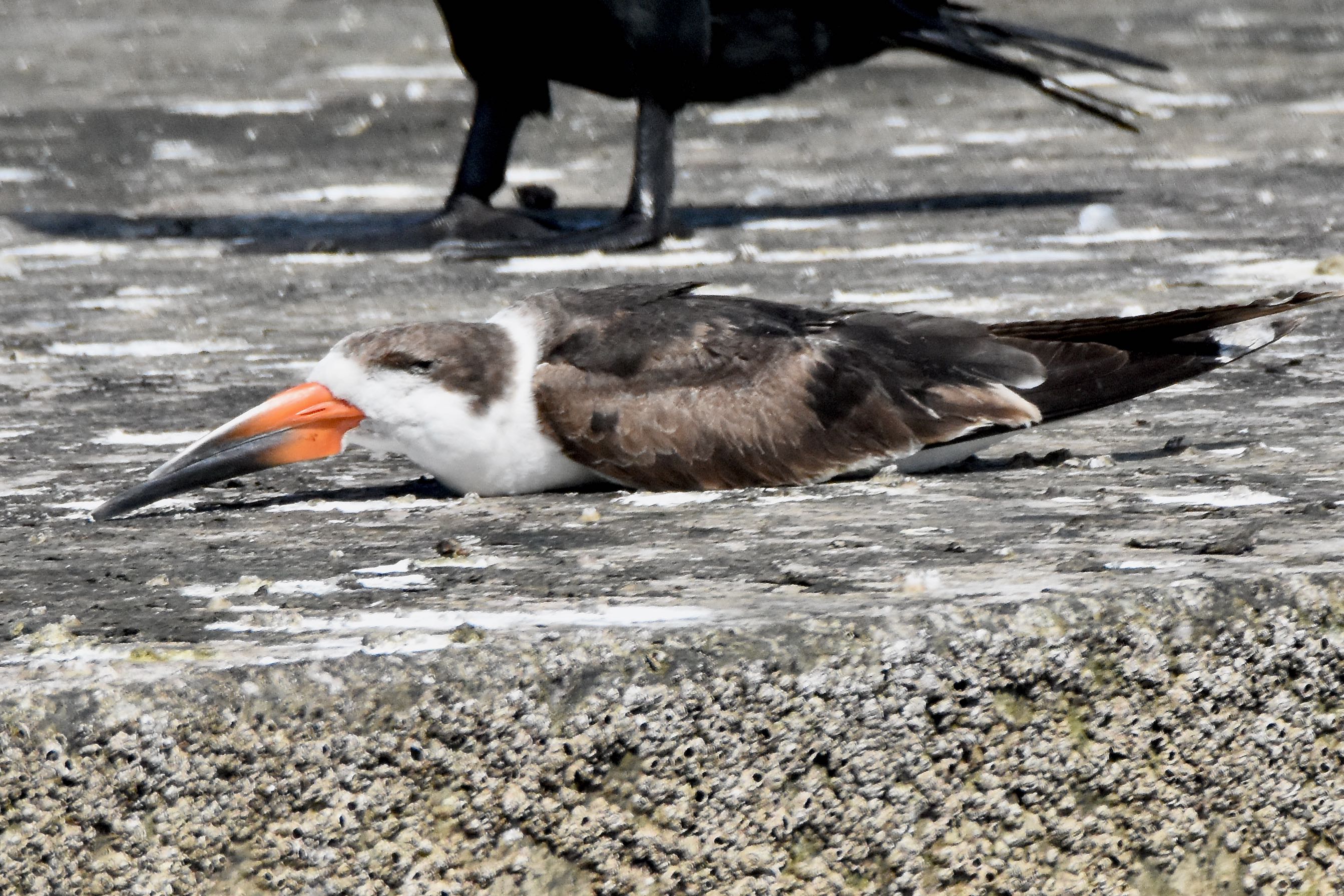
Black skimmer, photographed at Biscayne National Park, Homestead, Miami-Dade County, in February 2018.
This is a bird with a serious under-bite, but this under-bite is a feature rather than a flaw. The mandibles, or jaws, of the black skimmer, Rynchops niger, don’t align like they do in most animal species. Instead, the bottom mandible is much longer than the top.
The combination allows the bird to do one cool trick: As it flies low, just above the water, it drops the lower mandible below the surface, skimming if you will, until it hits a fish, which triggers it to instantly snap its mouth shut. Dinner! That odd jaw and its sharp black and white plumage distinguishes the skimmer from any other North American bird.
Black skimmers are Florida natives, found in coastal areas throughout the state, with some exceptions. It can also be found along Lake Okeechobee and other inland lakes and man-made bodies of water in South Florida. Its year-round range extends as far north as North Carolina along the Atlantic coast, but migrating skimmers can found in summer as far north as Massachusetts and along the Gulf coast through Texas and into Mexico.
Along the Pacific coast, it can be found living year-round in California just north of San Francisco Bay, south into Mexico and along the Bay of California. Some black skimmers nest inland along the Salton Sea, a saline lake in Southern California.
Black skimmers are fairly large shore birds, going 16 to 20 inches from head to tail and with a wingspan that approaches four feet. At a distance they look mostly black with a white face below the eyes, white neck and underparts. The bill is two-toned, black from about the midpoint to the tip, orange from the midpoint to the base. The mix recalls another shore bird, the American oystercatcher, but for starters, the oystercatcher’s bill is all orange and thinner than the black skimmer.
One other unusual feature: black skimmers have vertical pupils that narrow to slits in order to reduce glare.
Most of its foraging is done as described above. It hunts solely by touch rather than by sight. During the day, black skimmers are often seen resting on the beach with their entire bodies, head and bill included, on the ground just like our guy pictured above. They’ll wait until evening or night when the waters calm a bit to begin their daily foraging. Rarely, they’ll wade looking for food. Shrimp is also on their menu.
In Florida, nesting season runs between May and early September. Skimmers form nesting colonies, sometimes gathering in small groups, sometimes by the hundreds. And they’re finicky about the nest site. Even after the nest is constructed but before the first eggs are laid, they might pack up and move to a different place. Several times, in fact. The nest itself is a scrape on a sandy beach or sandbar above the wrack line (where high tide deposits seaweed and other debris). They’ll also nest on gravel roofs. Females typically lay four or five eggs, one every day or two, incubated by both parents. Incubation is for 21 to 25 days after the last egg is laid. Both parents also feed their offspring by regurgitating their catch. Black skimmers are born with equal upper and lower mandibles so they can pick up whatever food their parents drop on the ground. First flight is at 23 to 25 days after hatching.
In the late 19th and early 20th centuries, black skimmer eggs were commercially harvested, and the birds were hunted for their feathers to fill demand by the fashion industry. The combination seriously depleted the black skimmer population. A recovery began after the feds passed the Migratory Bird Treaty Act in 1918, but their numbers are low enough that they still are legally classified as threatened in Florida. Globally, the black skimmer numbers have plummeted over the last 50 years or so as the bird faces threats from loss of habitat, degraded habitat and sea level rise. Disturbances by beachgoers is also a problem. The North America Waterbird Conservation Plan produced by the U.S. Fish and Wildlife Service, considers black skimmers a “species of high concern.”
While they can be found nesting on both of Florida’s coasts, the numbers on the Atlantic side have dwindled to the point where successful nests are rarely found. They don’t nest in extreme South Florida nor in the Big Bend area of the Gulf Coast.
There were less than 4,000 individual black skimmers in Florida, according to a 2013 draft report prepared by the Florida Fish and Wildlife Conservation Commission, which in turn cited a study done six years prior. According to the report, there were some three dozen nesting sites in the state, 22 on the ground and 14 on gravel rooftops. The goal set in the draft was to increase the skimmer population to 4,000 nesting pairs, more than doubling the estimated number at the time. The keys: protecting and preserving nesting sites and managing enough habitat to support population growth.
Black skimmers are members of Laridae, the family of gulls, terns, skuas and skimmers.
Biscayne National Park
